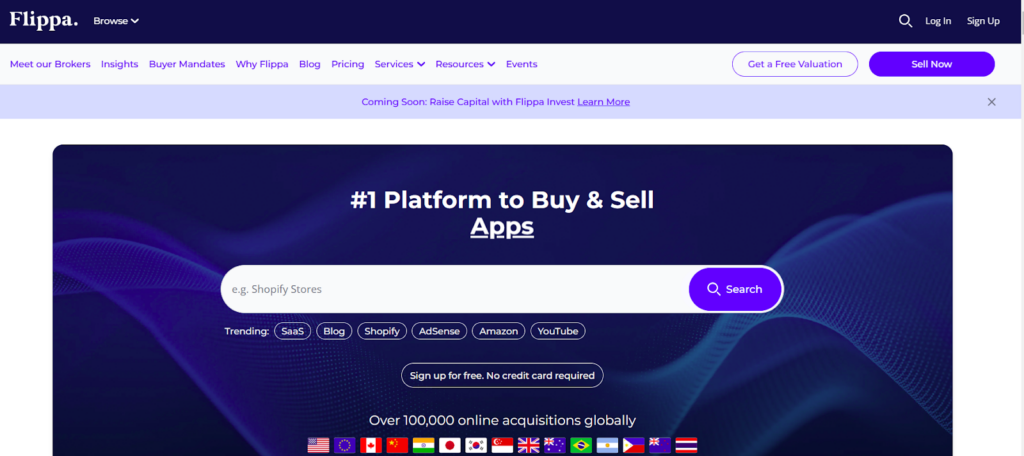The Flippa platform is the largest marketplace for buying and selling digital assets like websites, apps, domains, and even SaaS businesses. Known for facilitating over $200 million in transactions since its launch, Flippa has garnered a reputation as the “eBay of digital businesses.” The platform offers an accessible entry point for entrepreneurs looking to buy a business, side hustlers, and investors looking to grow their income by acquiring digital properties on marketplaces like Flippa.
Though Flippa presents genuine opportunities for profit, success heavily depends on the buyer’s ability to navigate its marketplace effectively and perform due diligence to minimize risks. This article will explore how Flippa works, the types of assets available, potential risks, and strategies to make money using the platform.
Key Takeaways
- Flippa is a legitimate platform for buying and selling digital assets, but due diligence is essential to avoid scams.
- The most popular listings include websites, SaaS businesses, mobile apps, and domains, offering diverse opportunities.
- Strategies like “Buy and Hold” or “Flipping for Profit” cater to both long-term investors and quick-profit seekers.
- Key risks include unverified metrics, manipulated data, and low-quality assets requiring extensive improvement.
- Thorough research, niche expertise, and strong management plans are crucial for the success of Flippa.
What Is Flippa and How Does It Work?

The Flippa marketplace functions similarly to an auction site but is tailored for digital businesses. Sellers list their assets, and buyers can either bid in auctions or directly purchase listings at their asking price. Each listing provides critical details, such as financial performance, traffic statistics, and growth potential, allowing buyers to assess its value.
Types of Digital Assets Sold on Flippa
- SaaS Companies: Businesses offering Software-as-a-Service (SaaS) are popular on Flippa because of their recurring revenue models. Buyers often seek these assets for their scalability and predictable income streams.
- Shopify and eCommerce Websites: Many eCommerce entrepreneurs use Flippa to buy established Shopify stores or niche eCommerce websites with existing customer bases, streamlining their entry into online retail.
- Blogs Monetized by AdSense: Content sites that generate income through advertising, such as Google AdSense, are frequently sold on Flippa. Buyers may scale these blogs by increasing traffic or diversifying monetization strategies.
- Social Media Accounts: Social media properties, including YouTube channels with monetization enabled or high follower counts, are also traded, offering buyers a head start in the creator economy.
- Domains: Flippa is a hotspot for domain traders who either flip domains for profit or use them to create online businesses.
- Mobile Apps: Mobile apps with active user bases and revenue streams are often listed, appealing to buyers looking to enter the app development industry without starting from scratch.
Why Flippa Appeals to Buyers
- Wide Range of Assets: Flippa caters to a diverse audience, offering assets priced as low as $100 and as high as $1 million or more.
- Varied Business Models: Buyers can explore businesses with different monetization strategies, from subscription models to affiliate marketing on platforms like Flippa.
- Global Reach: The platform connects buyers and sellers worldwide, increasing the likelihood of finding an asset that fits the needs of those looking to buy digital businesses.
Is Flippa Legit?

Flippa provides a legitimate platform for buying and selling digital assets like websites, apps, and domains. However, the platform’s vetting and verification process, coupled with varying user experiences, has made it essential for buyers to approach with caution and conduct thorough due diligence before making a purchase.
Vetting and Verification Process
Flippa operates as an open marketplace, allowing sellers who want to sell their digital assets to list them with relative ease. While this approach increases accessibility for sellers and buyers alike, it also means that the platform’s vetting process is minimal, especially for assets priced below $50,000. For more details on current listings and insights into the marketplace, visit Flippa.com.
Sellers are required to provide basic information, such as financial performance and traffic metrics, but Flippa does not always rigorously verify these claims.
This lack of thorough verification has resulted in some sellers manipulating financial data or traffic analytics to make their listings appear more attractive. For example:
- Fake Revenue Claims: Sellers may artificially inflate revenue figures by including short-term promotional income that is unsustainable or unrelated to the core business model.
- Manipulated Traffic Data: Some listings may show suspicious traffic spikes, often generated through bots or low-quality paid sources, creating a false impression of popularity and potential—if a listing looks too good to be true, it probably is.
While Flippa does offer optional escrow services and tools for buyers to verify claims, many sellers do not always provide full transparency, leaving inexperienced buyers vulnerable to scams.
User Experiences on Flippa
Positive Experiences
Despite its flaws, many users have successfully leveraged Flippa to find profitable opportunities. Buyers who dedicate time to researching and verifying data often report positive outcomes, and an experienced flipper can spot undervalued assets, but many sellers exaggerate traffic and revenue figures to make listings appear more attractive. For instance:
- Well-Established Websites: Listings that include six months or more of verified revenue tend to be safer investments, as they provide a more consistent track record of performance.
- Growth Potential: Buyers who identify undervalued assets with room for improvement, such as underperforming websites with solid niche potential, can scale them for greater profitability. Whether you’re looking to buy or sell, understanding market trends is crucial.
Negative Experiences
Unfortunately, not all transactions on Flippa are successful. Common complaints include:
- Fake Revenue Claims: Some Flippa listings exaggerate income by misrepresenting short-term spikes in revenue as sustainable earnings.
- Inflated Traffic Metrics: Listings may feature inflated traffic numbers, which are later discovered to be the result of junk backlinks, bots, or one-time marketing campaigns that do not reflect organic growth.
- Low-Quality Assets: Many lower-priced listings are created by novice sellers or individuals looking to offload poor-performing websites. These assets often require significant time and resources to make profitable before achieving a high selling price.
- Scams and Fraudulent Listings: Suspicious patterns, such as sudden traffic surges or revenue spikes that coincide with the sale listing, are often red flags. These indicators suggest that the seller may have artificially manipulated data to deceive buyers.
Red Flags to Watch For
- Unverified Metrics: If you’re looking to buy, and ensure revenue and traffic data are independently verified with tools like Google Analytics, it’s a warning sign.
- Suspicious Spikes: Sudden increases in traffic or revenue without a clear explanation should raise concerns.
- Junk Backlinks: Assets with a large number of spammy or irrelevant backlinks may suffer long-term SEO issues, making them difficult to scale.
Can You Really Make Money on Flippa?

The short answer is yes—it is possible to make money with Flippa, but your success depends on having a clear strategy, experience, and a willingness to conduct thorough research. The platform provides access to a wide range of digital assets, from websites and domains to SaaS businesses and mobile apps, offering various paths to profitability. However, as with any investment, earning a profit on Flippa requires careful analysis, due diligence, and an understanding of the market dynamics for digital properties.
Popular Types of Listings on Flippa
1. Content Websites
Blogs and authority websites that earn revenue through ads or affiliate marketing are among the most popular types of listings on Flippa. These websites appeal to buyers because:
- They generate passive income through advertising platforms like Google AdSense or affiliate programs like Amazon Associates.
- They can be scaled by increasing traffic, improving search engine optimization (SEO), or diversifying monetization strategies.
For instance, purchasing a niche blog with steady organic traffic and expanding its content library can significantly increase revenue. However, scaling these assets often requires strong knowledge of SEO, keyword research, and content marketing.
2. SaaS Companies
Software-as-a-Service (SaaS) businesses are another lucrative category on Flippa, especially for buyers with technical knowledge or access to development resources. These companies often appeal to investors because of their recurring revenue models, which provide stable and predictable income.
- High Returns: SaaS businesses that solve niche problems or have a loyal customer base can yield substantial profits.
- Scalability: By adding features, improving user experience, or expanding marketing efforts, buyers can significantly grow the value of a SaaS business. However, managing a SaaS company can be challenging without technical expertise, as it requires ongoing updates, customer support, and infrastructure maintenance.
3. Domains
Domain flipping—buying undervalued domain names and reselling them at a higher price—is another popular way to make money on Flippa. Success in this niche often depends on understanding market trends and recognizing domains with high demand.
- Market Trends: Domains that are short, memorable, and related to trending industries (e.g., AI, green energy, or cryptocurrency) often command higher prices.
- Risk and Patience: Domain flipping is speculative and may take time, as finding the right buyer who values the domain’s potential is critical. Some investors purchase domains in bulk and sell only a fraction at a premium, which offsets the costs of unsold inventory.
4. Mobile Apps
Affordable mobile apps, especially those with AI-powered tools or unique features, can generate steady passive income for buyers. Apps that are already listed on platforms like the App Store or Google Play and have an active user base are particularly appealing.
- Passive Income: Apps with in-app purchases, subscription models, or advertising revenue streams can provide ongoing earnings.
- Maintenance Required: To ensure continued success, app owners must regularly update the app to address bugs, enhance user experience, and remain compatible with operating system updates.
- Growth Potential: Buyers can scale apps by improving user acquisition strategies, such as implementing targeted marketing campaigns or optimizing app store listings.
Tips for Successful Investments on Flippa

Buying a website on Flippa can be a profitable venture when approached strategically, but success requires a strategic approach and a thorough understanding of the marketplace. Here are detailed tips to help ensure your investments are successful:
1. Conduct Thorough Due Diligence
Before purchasing any asset, it is crucial to verify the information provided by the seller to avoid potential scams or poorly performing investments. Key areas to focus on include:
- Verify Traffic Metrics: Request access to Google Analytics or other analytics tools to confirm the authenticity of the website’s traffic. Pay attention to the traffic sources (organic, referral, direct) and ensure that the traffic is sustainable and not artificially inflated through bots or short-term ad campaigns.
- Analyze Revenue Data: Ask for verified financial reports, such as profit and loss statements or screenshots of earnings from platforms like AdSense or Shopify. This helps ensure that the reported revenue is accurate and consistent over time.
- Check Backlink Profiles: Use SEO tools like Ahrefs or SEMrush to assess the quality of backlinks pointing to the asset. Watch for toxic backlinks or signs of link farming, which can harm the website’s search engine ranking in the long term.
- Evaluate Conversion Rates: High traffic doesn’t always translate to high revenue. Review the website or app’s conversion rates (e.g., sales, ad clicks, or user sign-ups) to determine if the traffic is valuable. If traffic numbers are high but conversions are low, it could be a red flag indicating poor user engagement or manipulated traffic metrics.
2. Understand the Niche
Investing in a niche where you have expertise or interest significantly reduces the risk of failure. Being familiar with the niche allows you to better evaluate the asset’s potential and understand the work required to maintain or improve it.
- Why Expertise Matters: For example, if you are familiar with SEO and content management, buying a blog or authority website may be a better choice as you can optimize its performance and grow its revenue. Similarly, knowledge of app development can help you manage and enhance mobile apps effectively.
- Research the Niche: Even if you lack expertise, conduct thorough research to understand the industry trends, audience behavior, and competition. Look for niches with growing demand and avoid saturated or declining markets.
3. Start Small
For beginners, starting with smaller investments is a practical way to learn the ropes without taking on significant financial risks.
- Choose Low-Risk Assets: Opt for websites or blogs generating consistent, modest revenue. These assets are generally less expensive and easier to manage compared to SaaS businesses or apps.
- Build Experience Gradually: Starting small allows a beginner flipper to gain hands-on experience in managing a digital asset, including understanding its operations, traffic patterns, and revenue generation methods. This learning process prepares you for larger, more complex investments in the future.
4. Develop a Maintenance Plan
Purchasing a digital asset is only the first step; the real work begins after the acquisition. A solid maintenance and growth strategy is essential to maximize your investment.
- SEO Optimization: Regularly update the website’s SEO to maintain or improve its search engine rankings. This includes optimizing existing content, targeting new keywords, and building high-quality backlinks.
- Content Updates: Keep the content fresh and relevant to engage the audience and maintain traffic. For blogs and authority sites, this means publishing new articles, updating outdated information, and ensuring the content aligns with user needs.
- Regular Traffic Monitoring: Continuously monitor the website’s traffic using tools like Google Analytics. Keep an eye on traffic sources, user behavior, and potential drops in traffic to address issues promptly.
- App Updates: If you purchase a mobile app, ensure it remains compatible with the latest operating system updates and regularly fix bugs to enhance user experience. Adding new features based on user feedback can also drive growth.
Flippa Strategies: Buy, Hold, or Flip?
When investing in digital assets on Flippa, your approach will largely depend on your goals, expertise, and resources. Whether you’re looking for steady passive income, quick profit, or an entry point into the digital marketplace, the Buy, Hold, or Flip strategies each offer unique benefits and challenges. Let’s explore these strategies in more detail in the table below.
| Strategy | Description | Ideal Candidates | Why It Works | Requirement | Challenges | Example |
| Buy and Hold | Long-term strategy to grow digital assets and generate passive income. | Established websites, blogs, or SaaS businesses with consistent revenue streams. | Steady income and long-term growth through SEO, content updates, and user engagement. | Resources for growth (tools, content creation, marketing) and patience for ongoing maintenance. | Time-intensive to scale requires consistent management and investment. | Buy a blog earning $500/month and improve SEO to grow it to $1,000/month for long-term revenue. |
| Flipping for Profit | Short-term strategy to buy undervalued assets, improve them, and sell for a higher price. | Underperforming websites, eCommerce stores, or SaaS apps with growth potential. | Quick returns by enhancing traffic, design, or monetization strategies. | Expertise in SEO, marketing, or app development; significant time commitment for fast improvements. | Labor-intensive, and success depends on identifying high-potential assets. | Buy a site earning $2,000/month for $10,000, grow revenue to $4,000/month, and sell for $30,000. |
| Domain Flipping | Buy undervalued domains and resell for higher prices, capitalizing on market trends. | Short, memorable domain names or domains related to trending industries (e.g., AI, crypto). | Low maintenance; demand for niche or high-value domains drives resale potential. | Understanding of market demand and trends; patience to wait for the right buyer. | Highly speculative, competitive market, and some domains may not sell quickly or at all. | Buy “AIJobsHub.com” for $300 and sell it to a startup for $2,000. |
How to Use This Matrix
- Beginners: Focus on domain flipping or small-scale buy-and-hold investments for a lower-risk entry point.
- Experienced Investors: Leverage the flipping-for-profit strategy to maximize returns through rapid improvements.
- Long-Term Investors: Invest in the buy-and-hold strategy for consistent passive income and scalable growth.
Conclusion: Is Flippa Worth It?
Flippa can be a valuable tool for digital entrepreneurs, but it is not a guaranteed path to success. Whether you aim to make money by flipping websites or holding them as long-term investments, success depends on:
- Conducting thorough research
- Understanding the niche
- Carefully evaluating listings
Flippa is not a “get rich quick” platform. Instead, it requires time, expertise, and a solid strategy to maximize your chances of success. If you’re looking for opportunities to profit in the digital space, Flippa offers a legitimate marketplace, but it demands due diligence and an informed approach.
Ready to maximize your online business’s value and uncover profitable opportunities? Visit Softlist.io today for expert insights and tools to succeed in the digital marketplace.
FAQs
How Does Flippa Make Money?
Flippa earns revenue through its fee structure, which includes listing fees, success fees (a percentage of the final sale price), and premium services like enhanced visibility for listings and verification tools. Additionally, Flippa takes a cut from completed sales, which varies depending on the asset’s value.
How Can I Tell If a Website or Business on Flippa Is Legit?
To verify the legitimacy of a website or business listed on Flippa, review financial data, traffic metrics, and backlink profiles using tools like Google Analytics and SEMrush. Always research before buying to ensure the asset’s claims are backed by reliable data. Look for verified listings and avoid assets with suspicious traffic or revenue spikes.
Is It Safe to Sell on Flippa If My Site Doesn’t Sell?
Yes, it is generally safe to sell on Flippa if you provide accurate, verifiable data and use escrow services to secure transactions. However, if your site doesn’t sell, you may need to adjust your pricing, improve the listing details, or use Flippa’s premium features for increased visibility. Transparency and clear communication with buyers also help build trust.
Can I Make Money as a Flipper on Flippa?
Absolutely! Many entrepreneurs make money as flipper by purchasing undervalued websites, improving their performance, and selling them for a higher price. Success depends on choosing the right assets, optimizing their revenue streams, and conducting thorough due diligence before making a purchase.
What Are the Risks of Using Flippa?
Risks include encountering scams, unverified data, or low-quality assets. These can be mitigated by conducting research before buying, analyzing data carefully, and using Flippa’s verification and escrow services. Additionally, be cautious of misleading traffic data or exaggerated revenue claims that some sellers may present.
How Do I Find Active Listings at Flippa?
To browse active listings at Flippa, visit the platform and filter searches based on asset type, revenue, traffic, or price range. Whether you’re looking for a profitable website, SaaS business, or domain, staying updated on new listings increases your chances of finding a great deal.







